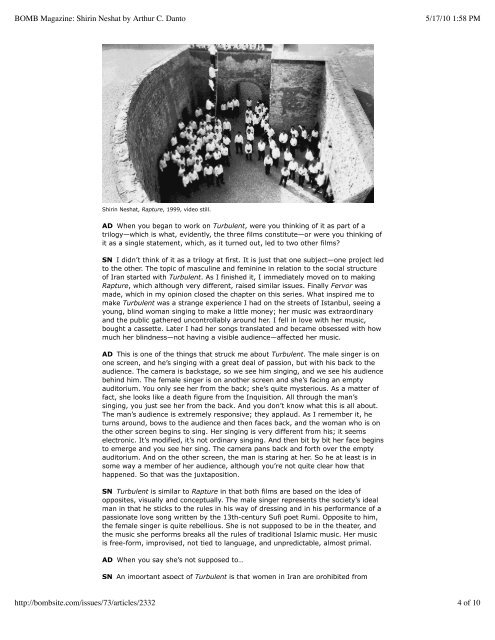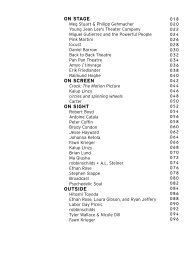BOMB Magazine: Shirin Neshat by Arthur C. Danto
BOMB Magazine: Shirin Neshat by Arthur C. Danto
BOMB Magazine: Shirin Neshat by Arthur C. Danto
You also want an ePaper? Increase the reach of your titles
YUMPU automatically turns print PDFs into web optimized ePapers that Google loves.
Iranian crew.<br />
<strong>BOMB</strong> <strong>Magazine</strong>: <strong>Shirin</strong> <strong>Neshat</strong> <strong>by</strong> <strong>Arthur</strong> C. <strong>Danto</strong> 5/17/10 1:58 PM<br />
<strong>Shirin</strong> <strong>Neshat</strong>, Rapture, 1999, video still.<br />
AD When you began to work on Turbulent, were you thinking of it as part of a<br />
trilogy—which is what, evidently, the three films constitute—or were you thinking of<br />
it as a single statement, which, as it turned out, led to two other films?<br />
SN I didn’t think of it as a trilogy at first. It is just that one subject—one project led<br />
to the other. The topic of masculine and feminine in relation to the social structure<br />
of Iran started with Turbulent. As I finished it, I immediately moved on to making<br />
Rapture, which although very different, raised similar issues. Finally Fervor was<br />
made, which in my opinion closed the chapter on this series. What inspired me to<br />
make Turbulent was a strange experience I had on the streets of Istanbul, seeing a<br />
young, blind woman singing to make a little money; her music was extraordinary<br />
and the public gathered uncontrollably around her. I fell in love with her music,<br />
bought a cassette. Later I had her songs translated and became obsessed with how<br />
much her blindness—not having a visible audience—affected her music.<br />
AD This is one of the things that struck me about Turbulent. The male singer is on<br />
one screen, and he’s singing with a great deal of passion, but with his back to the<br />
audience. The camera is backstage, so we see him singing, and we see his audience<br />
behind him. The female singer is on another screen and she’s facing an empty<br />
auditorium. You only see her from the back; she’s quite mysterious. As a matter of<br />
fact, she looks like a death figure from the Inquisition. All through the man’s<br />
singing, you just see her from the back. And you don’t know what this is all about.<br />
The man’s audience is extremely responsive; they applaud. As I remember it, he<br />
turns around, bows to the audience and then faces back, and the woman who is on<br />
the other screen begins to sing. Her singing is very different from his; it seems<br />
electronic. It’s modified, it’s not ordinary singing. And then bit <strong>by</strong> bit her face begins<br />
to emerge and you see her sing. The camera pans back and forth over the empty<br />
auditorium. And on the other screen, the man is staring at her. So he at least is in<br />
some way a member of her audience, although you’re not quite clear how that<br />
happened. So that was the juxtaposition.<br />
SN Turbulent is similar to Rapture in that both films are based on the idea of<br />
opposites, visually and conceptually. The male singer represents the society’s ideal<br />
man in that he sticks to the rules in his way of dressing and in his performance of a<br />
passionate love song written <strong>by</strong> the 13th-century Sufi poet Rumi. Opposite to him,<br />
the female singer is quite rebellious. She is not supposed to be in the theater, and<br />
the music she performs breaks all the rules of traditional Islamic music. Her music<br />
is free-form, improvised, not tied to language, and unpredictable, almost primal.<br />
AD When you say she’s not supposed to…<br />
SN An important aspect of Turbulent is that women in Iran are prohibited from<br />
singing in public, and there are no recordings <strong>by</strong> female musicians. The piece took<br />
off in various directions and brought about other important questions about the<br />
http://bombsite.com/issues/73/articles/2332 male and female contrast in relation to the social structure. The ultimate question<br />
4 of 10<br />
was how each would go about reaching a level of mystical expression inherent in<br />
the Sufi music.<br />
AD But her song is not a traditional song.






